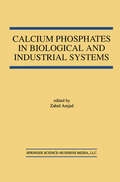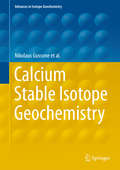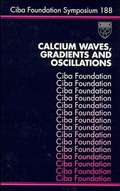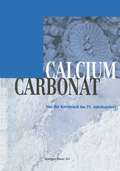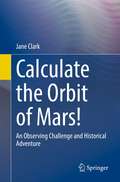- Table View
- List View
Calcium Protein Signaling (Advances in Experimental Medicine and Biology #255)
by H. HidakaThe Sixth International Symposium on Calcium-Binding Proteins in Health and Disease was held in Nagoya, Japan, July 24-28, 1988. Four hundred and seventy-two persons participated in this symposium. This large attendance is proof indeed of the growing interest in this field of research. Previous meetings were held in Jablonna, Poland in 1973; Ithaca, New York in 1977, Madison, Wisconsin in 1980; Trieste, Italy in 1983 and in Asilomar, California in 1986. The scientific program of this 1988 meeting included forty-one oral presentations given by invited specialists, ten round table presentations and one hundred and eighty-seven poster presentations. The program was set-up by the Organizing Committee and the members were Hidaka, H. (Japan), Forsen, S. (Sweden), Klee, C. B. (U. S. A. ), Means, A. R. (U. S. A. ), Norman, A. W. (U. S. A. ) and Sykes, B. D. (Canada). The members of the Advisory Committee, Carafoli, E. (Switzerland), Gergeley, J. (U. S. A. ), Kretsinger, R. H. (U. S. A. ), MacLennan, D. H. (Canada), Siegel, F. L. (U. S. A. ), Vanaman, T. C. (U. S. A. ), Wasserman, R. H. (U. S. A. ) and Williams, R. J. P. (England) provided important suggestions and advice to the Committee. This volume includes contents of the talks given by the invited speakers and some, but not all of the free communications. The contributions are grouped according to subject and based on the classification made by the editor.
Calcium reacting with Sulphuric Acid (tactile)
by Sheffield Vi ServiceThis labelled diagram shows the results of reacting calcium with sulphuric acid.
Calcium reacting with Water (tactile)
by Sheffield Vi ServiceThis labelled diagram shows the results of reacting Calcium with Water.
Calcium reaction water - Resulting chemicals (tactile)
by Sheffield Vi ServiceThis is a labelled diagram showing the chemicals produced when calcium reacts with water.
Calcium Regulating Hormones, Vitamin D Metabolites, and Cyclic AMP Assays and Their Clinical Application
by RogerBouillon Franz PaulArmbruster HeinrichSchmidt-GaykCalcium Regulation by Calcium-Binding Proteins in Neurodegenerative Disorders (Neuroscience Intelligence Unit)
by Claus W. Heizmann Katharina BraunCalcium Regulation of Cellular Function (ISSN #Volume 30)
by Paul Greengard Angus C. Nairn Shirish Shenolikar Anthony R. MeansVolume 30 examines the prominent role of calcium as an intracellular second messenger. Leading investigators review a wide variety of studies on how calcium enters and moves through cells, how it interacts with its many binding proteins, and how calcium and its intracellular receptor, calmodulin, control vital cellular processes. Coverage includes a detailed analysis of the mechanisms by which calcium bound to calmodulin regulates contractile proteins in smooth muscle cells. Close attention is given to the roles of calcium and calmodulin-dependent protein kinases and phosphatases in synaptic signal transduction, protein synthesis, gene expression, programmed cell death, activation of T-lymphocytes, and control of cell division cycles. Other chapters discuss studies using genetically manipulable nonmammalian organisms to further proble the functions of calcium and calmodulin.
Calcium-Sensing Receptor (Endocrine Updates #19)
by Naibedya Chattopadhyay Edward M. BrownCalcium-Sensing Receptor provides an overview of various aspects of the calcium receptor's biochemistry, physiology and pathophysiology that is suitable both for those who have been working in the field of Ca2+0-sensing as well as those who are new to this discipline. Calcium-Sensing Receptor is the nineteenth volume published in the Endocrine Updates book series under the Series Editorship of Shlomo Melmed, MD.
Calcium Signaling (Advances in Experimental Medicine and Biology #1131)
by Md. Shahidul IslamThis volume contains a unique selection of chapters covering a wealth of contemporary topics in this ubiquitous and diverse system of cell signaling. It offers much more than the accessibility and authority of a primary text book, exploring topics ranging from the fundamental aspects of calcium signaling to its varied clinical implications. It presents comprehensive discussion of cutting-edge research alongside detailed analysis of critical issues, at the same time as setting out testable hypotheses that point the way to future scientific endeavors. The contributions feature material on theoretical and methodological topics as well as related subjects including mathematical modeling and simulations. They examine calcium signaling in a host of contexts, from mammalian cells to bacteria, fruit fly and zebrafish. With much of interest to newcomers to the field as well as seasoned experts, this new publication is both wide-ranging and authoritative.The chapter “Calcium Signaling: From Basic to Bedside” is available open access under a Creative Commons Attribution 4.0 International License via link.springer.com.
Calcium Signaling (Advances in Experimental Medicine and Biology #740)
by Md. Shahidul IslamCalcium signaling contains a unique selection of chapters that cover a wide range of contemporary topics in this ubiquitous and diverse system of cell signaling. This book has the flavor of a primary text book, but it is much more than that. It covers topics ranging from the fundamental aspects of calcium signaling to its clinical implications, in a thoughtful and comprehensive way. It discusses cutting edge researches, and critical issues at depth, and it presents many testable hypotheses for future research. It includes the theoretical and the methodological topics as well as topics related to mathematical modeling, and simulations. If you want to read about calcium signaling in different mammalian cells, oocytes, Zebrafishes, and even in plants, in one and the same book, then this book will not disappoint you. From the beginners to the experts in the field of calcium signaling, everybody will find something useful in this very timely book.
Calcium Signaling: From Physiology to Diseases
by Senthilkumar Rajagopal Murugavel PonnusamyThis book focuses on disorders of calcium channels and the use of drugs to treat calcium-related disorders and their associated toxicities. In particular, it discusses the role of various natural products and their attributes in preventing problems associated with calcium imbalances. In addition, the book analyzes trends in the processing of natural products using nanotechnology and their implications in calcium-related disorders. Lastly, it explores some of the most promising aspects of research into calcium signalling disorders – which is especially important, given the wide variety of cellular processes that are controlled by calcium ions – and provides a trustworthy source of up-to-date information in this area of research.
Calcium Signaling In Airway Smooth Muscle Cells
by Yong-Xiao WangThis book explores the role calcium signaling plays in cellular responses in almost all types of cells including airway smooth muscle cells. This universal signaling may result from extracellular calcium influx and/or intracellular calcium release, which are precisely controlled and regulated by ion channels, exchangers and/or transporters on the plasmalemmal or sarcoplasmic reticulum membrane. First, several chapters detail calcium release channels (ryanodine receptors and inositol trisphosphate receptors), voltage-dependent potassium channels, transient receptor potential channels, Orai channels, calcium-activated potassium channels, and calcium-activated chloride channels. Well-characterized sodium-calcium exchangers, voltage-dependent calcium channels, and calcium pumps are described also in depth over many chapters. Ca2+ signaling can be expressed in Ca2+ sparks, waves, oscillations, and global changes in intracellular Ca2+ concentration. Calcium in subcellular compartments (cytosol, sarcoplasmic reticulum, mitochondria, and caveolae) also exhibit dynamic crosstalk. Many molecules including FK506 binding proteins, cyclic adenosine diphosphate ribose, reactive oxygen species, RhoA kinases, caveolin and integrins can modify and induce spatial, temporal and compartmental variations of calcium signaling. In addition, calcium signaling can exhibit sex hormone- and age-dependent changes. A number of chapters are dedicated to covering these diverse formats, spatiotemporal characteristics, multifaceted network and mathematical modeling of Ca2+ signaling. Neurotransmitters, hormones, growth factors, inflammatory cytokines, and other stimuli may lead to multiple cellular responses by inducing Ca2+ signaling in airway smooth muscle cells. Increasing evidence suggests that Ca2+ pumps and canonical transient receptor potential channels are essential for airway smooth muscle remodeling. Accordingly, several chapters summarize recent advances in the studies of the key role of calcium signaling in physiological cellular responses as well as the development of asthma, chronic obstructive pulmonary disease and other respiratory disorders.
Calcium Signaling Protocols (Methods in Molecular Biology #937)
by David G. Lambert and Richard D. RainbowThe regulation of intracellular Ca2+ has continued to be a powerful area of study since the publication of the first and second editions of Calcium Signaling Protocols, and the developments in the field have also, naturally, continued. With the third edition, expert contributors explore some of the exciting new molecular techniques that have both enabled new studies of intracellular Ca2+ regulation and provided much new information on processes. Comprised of five main section, the book covers theoretical and very simple suspension-based fluorimetric assays, specialist measurement systems, measurement of channel activity, measurement of store release, as well as specialist measurement techniques which include targeted probes, using G-protein chimeras to force Ca2+ signalling for screening, and genetically encoded sensors. Written in the highly successful Methods in Molecular Biology™ series format, chapters include introductions to their respective topics, lists of the necessary materials and reagents, step-by-step, readily reproducible laboratory protocols, and tips on troubleshooting and avoiding known pitfalls. Updated and accessible, Calcium Signaling Protocols, Third Edition will be a valuable reference for all those contemplating a move into the study of intracellular Ca2+.
Calcium Signaling Protocols (Methods in Molecular Biology #114)
by David G. Lambert2+ The regulation of intracellular Ca is a common theme presented in many 2+ papers over the last 20 or so years, and the description of the Ca -sensitive indicator dye fura 2 in 1985 resulted in a massive increase in these types of 2+ studies. Aspects of the regulation of intracellular Ca have been dealt with in many of the subsequent chapters and will therefore not be covered again. Calcium Signaling Protocols results from a chance discussion with Dr. R. I. Norman of the Department of Medicine at Leicester University and r- resents a major effort from a group of extremely helpful and very patient - thors. Putting a book like this together takes time and I am indebted to these authors without whom this project would have remained a chance discussion. I am also very grateful to Professor J. M. Walker, the series editor, for all his help and advice over the course of this project and particularly his help editing the first batch of chapters. I would also like to thank Dr E. L. Pallett for help and advice regarding interconversion of Mac and Word files and for archiving chapters.
Calcium Signaling Protocols (Methods in Molecular Biology #312)
by David G. LambertIn the first edition of Calcium Signaling Protocols I began by writing “The regula- 2+ tion of intracellular Ca is a common theme presented in many papers over the last 20 2+ or so years and the description of the Ca -sensitive indicator dye fura-2 in 1985 resulted in a massive increase in these types of studies. ” This statement is as true in 2005 as it was in 1999, but 20 or so years is now 30 years! There has been some reorganization of the volume such that there are now 22 ch- ters including five new ones, all written by experts in their field. These new chapters 2+ include use of the FlexStation and electrophysiological measurement of Ca channel activity. The book is broken into six parts. Part I is a general coverage of basic theory and the simplest use of fluorescent indicators. Part II covers specialist measurement 2+ systems and Part III covers measurement of Ca channel activity. Assessment of 2+ release of stored Ca is covered in some detail in Part IV, with Parts V and VI cover- 2+ ing specialist measurement techniques and Ca -sensitive targets. Putting a book like this together, even as a second edition, takes time and I am, again, indebted to the individual authors for their help and patience. I am also very grateful to Professor John M. Walker, the series editor, for his continued help and advice over the course of this project.
Calcium signalling: Approaches and Findings in the Heart and Blood
by Lars KaestnerThe book combines general concepts and methods to investigate calcium signalling in cells ranging from molecular biology approaches to manipulation of calcium in living cells. The focus within these methods in on the broad range of fluorescence imaging technology, in particular on optical sectioning techniques and fast image acquisition. In addition to these general guidelines there are application examples in a context beyond calcium signalling in two major fields: investigations of isolated cardiac myocytes and red blood cell related research. While the cellular cardiology section provides snapshots of certain calcium signalling aspects, the red blood cell part presents an overview from the functional identification of calcium-channels to a concept of physiological and pathophysiological relevance.
Calcium Signalling: Methods and Protocols (Methods in Molecular Biology #1925)
by Anna Raffaello Denis Vecellio ReaneThis volume looks at the latest developments in studying calcium signaling. The chapters in this book discuss topics such as in vitro and in vivo analyses in model systems; methods to measure Ca2+ in different subcellular compartments; single Ca2+ channels; methods to measure cellular ROS and ATP; and the functionality of the ATP synthase. Written in the highly successful Methods in Molecular Biology series format, chapters include introductions to their respective topics, lists of the necessary materials and reagents, step-by-step, readily reproducible laboratory protocols, and tips on troubleshooting and avoiding known pitfalls.Comprehensive and cutting-edge, Calcium Signalling: Methods and Protocols is a valuable resource that covers both conceptual and methodological viewpoints to aid beginners and experts in furthering their studies in the developing field of calcium homeostasis research.
Calcium Signalling and Disease: Molecular pathology of calcium (Subcellular Biochemistry #45)
by Ernesto Carafoli Marisa BriniAuthors highlight several promising discoveries in the field of calcium signaling that provide new information about both genetic and acquired pathologies. Their discussions will give you new insights into the underlying causes of congenital and acquired diseases and point the way to new, even more promising research and therapies.
Calcium Stable Isotope Geochemistry (Advances in Isotope Geochemistry)
by Nikolaus Gussone Anne-Désirée Schmitt Alexander Heuser Frank Wombacher Martin Dietzel Edward Tipper Martin SchillerThis book provides an overview of the fundamentals and reference values for Ca stable isotope research, as well as current analytical methodologies including detailed instructions for sample preparation and isotope analysis. As such, it introduces readers to the different fields of application, including low-temperature mineral precipitation and biomineralisation, Earth surface processes and global cycling, high-temperature processes and cosmochemistry, and lastly human studies and biomedical applications. The current state of the art in these major areas is discussed, and open questions and possible future directions are identified. In terms of its depth and coverage, the current work extends and complements the previous reviews of Ca stable isotope geochemistry, addressing the needs of graduate students and advanced researchers who want to familiarize themselves with Ca stable isotope research.
Calcium Transport and Intracellular Calcium Homeostasis (Nato ASI Subseries H: #48)
by Danielle Pansu Felix BronnerThe crucial role played by calcium as a cellular messenger has become increasingly evident, as has the recognition that cells spend much energy in maintaining the cytosolic concentration of this cation both constant and low. It is thought they do this to avoid precipitating phosphate, needed as a source of bond energy and to modulate protein structure. Moreover, since calcium that does enter the cell must be disposed with, processes that utilize calcium have evolved, e.g. secretion, contraction, signaling, to name just some. New knowledge concerning the processes of cellular calcium entry, extrusion and the fate of intracellular calcium has accumulated in recent years. Much has also been learned about calcium transport by and across epithelial cells. It seems logical to think that the processes of calcium entry, extrusion and intracellular handling are similar in all cells. We have therefore assembled in one volume overviews and research reports of transport and cellular calcium regulation so as to explore similarities and differences between cells that utilize calcium for metabolic purposes and those whose primary function is transport.
Calcium Waves, Gradients and Oscillations (Novartis Foundation Symposia #188)
by Gregory R. Bock Kate AckrillRenowned contributors provide comprehensive coverage of calcium gradients, waves and oscillations in diverse systems. Discusses the mechanisms initiating and sustaining calcium waves and their role in cell function. Describes studies using the latest techniques for measuring calcium ion gradients including chemiluminescent indicators.
Calculate the Orbit of Mars!: An Observing Challenge and Historical Adventure
by Jane ClarkThis book shows readers how to calculate the orbit of Mars, based on their own observations and using observations made by the author. The historical, observational, and analytical aspects of the project to measure the orbit of Mars are all combined in this one book!Determining the orbit of Mars is particularly important, as originally solving this problem required the founding of modern science. Clark discusses how people came to believe in the Newtonian model of the Solar System, works through the mathematical basis for the theory of gravity, and shows how Newton ruled out the possibility of alternative theories. Readers also learn how it became possible to accurately measure the positions of Mars from a moving, spinning platform—the Earth.This mid-level observational challenge is well within reach of most serious amateur astronomers. For the observations, only a telescope with auto-guiding capability and the ability to mount a digital single lens reflex (DSLR) camera is required. For the calculations, it is assumed that the reader has a science, engineering, or mathematics background and is familiar with calculus, vectors, and trigonometry.
Calculated Surprises: A Philosophy of Computer Simulation (Oxford Studies in Philosophy of Science)
by Johannes LenhardIf all philosophy starts with wondering, then Calculated Surprises starts with wondering about how computers are changing the face and inner workings of science. In this book, Lenhard concentrates on the ways in which computers and simulation are transforming the established conception of mathematical modeling. His core thesis is that simulation modeling constitutes a new mode of mathematical modeling that rearranges and inverts key features of the established conception. Although most of these new key features--such as experimentation, exploration, or epistemic opacity--have their precursors, the new ways in which they are being combined is generating a distinctive style of scientific reasoning. Lenhard also documents how simulation is affecting fundamental concepts of solution, understanding, and validation. He feeds these transformations back into philosophy of science, thereby opening up new perspectives on longstanding oppositions. By combining historical investigations with practical aspects, Calculated Surprises is accessible for a broad audience of readers. Numerous case studies covering a wide range of simulation techniques are balanced with broad reflections on science and technology. Initially, what computers are good at is calculating with a speed and accuracy far beyond human capabilities. Lenhard goes further and investigates the emerging characteristics of computer-based modeling, showing how this simple observation is creating a number of surprising challenges for the methodology and epistemology of science. These calculated surprises will attract both philosophers and scientific practitioners who are interested in reflecting on recent developments in science and technology.
